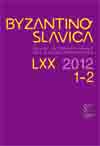A Case of Power and Subversion? The Fresco of St. Anna Nursing the Child Mary from the Monastery of Zaum
A Case of Power and Subversion? The Fresco of St. Anna Nursing the Child Mary from the Monastery of Zaum
Author(s): Elena Ene D-VasilescuSubject(s): History
Published by: AV ČR - Akademie věd České republiky - Slovanský ústav and Euroslavica
Summary/Abstract: SS. Anna and Elizabeth Galaktotrophousa or Mlekopitatelnitsa frescoes or icons are illustrative examples of the fact that creativity has always been expressed within Byzantine ecclesiastical artistic domain. That in spite of the general truth emphasised, among others, by E. Dauterman Maguire and H. Maguire that, ìThe very legitimacy of the holy image depended upon its adherence to tradition and its supposed accuracy in reproducing the prototype.î In this article I will speak about subversion in liturgical art, especially from the perspective of the iconographic canon and its power to regulate the creation of images in the Byzantine Church. It might seem that an act of subversion from within happened each time an artistic innovation occurred, as for example, in the case of the image of St. Anna nursing the infant Mary (a variant of the Virgo lactans). But was this really the case? And when an innovation became apparent, was it a conscious act of subversion? Also, another question is: did the painters themselves dare to stretch the canon to the limits, or this was a matter of patronage? The latter authors point out that ìthe pleasure of contradicting authority was an element in the Byzantine reception of unofficial imagery.î The question arises as to whether that was also occasionally the case with official and liturgical art in Byzantium. I shall endeavour to demonstrate that the Byzantine icon-painters, and those in all areas of the Empireís influence, managed to be inventive while remaining within the very canon of religious official art of icon and fresco painting. Therefore, they were not ësubversiveí. Certainly no stipulation within the canon established by the Church Synods with regard to the use of images forbids a representation as that of St. Anna Mlekopitatelnitsa from Zaum Monastery which triggered the writing of this work, whatever extremely ëbiologicí this fresco would appear to a puritan viewer. It proves that, if an innovation is made in the spirit of the canon, it is not subversive.
Journal: Byzantinoslavica - Revue internationale des Etudes Byzantines
- Issue Year: LXX/2012
- Issue No: 1-2
- Page Range: 241-264
- Page Count: 24
- Language: English
- Content File-PDF

